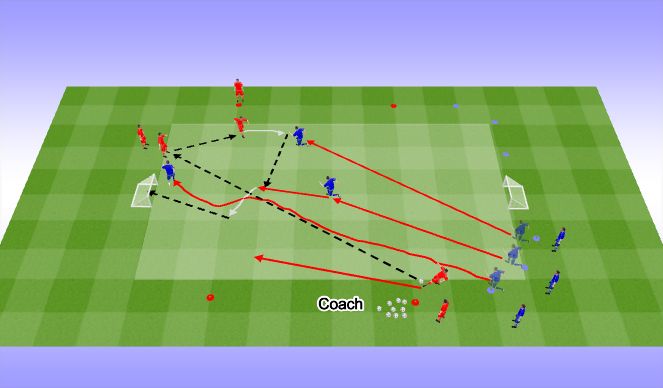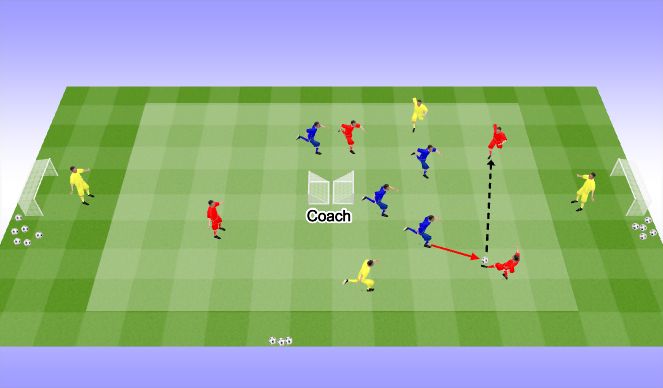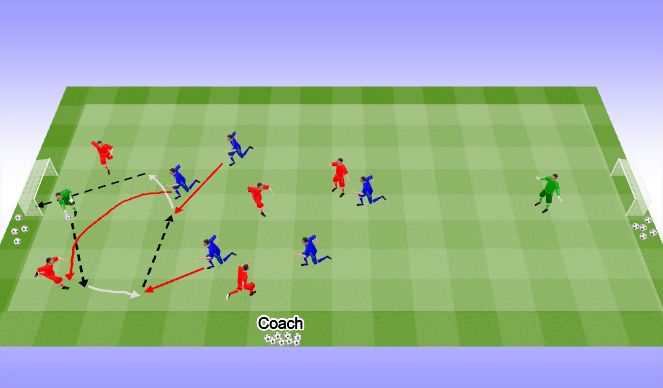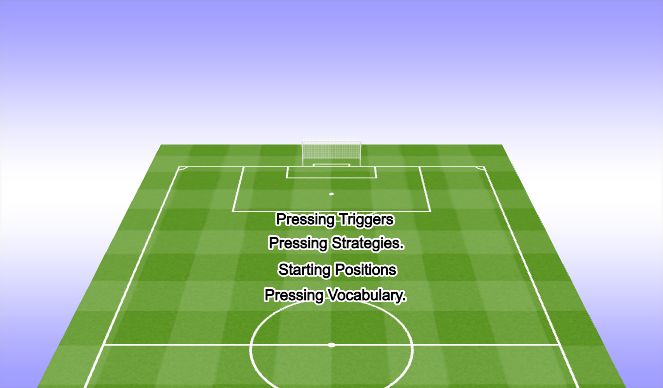Football/Soccer Session (Academy Sessions): Pressing Triggers & Possession.
Profile Summary

| Name: | DJ Ogunlade |
|---|---|
| City: | HAMILTON |
| Country: | United States of America |
| Membership: | Adult Member |
| Sport: | Football/Soccer |
Description
1. Recognizing pressing cues and triggers.
2. Starting positions to bait passes into the CBs and FBs.
3. Pressing as a team to regain possession and score goals.
4. Developing decision making - Play forward, circulate possession or recycling possession.
5. Develop positioning in order to create space.

See the guidance at the top of this page to understand why you are not seeing interactive Football/Soccer images.

Pressing Duels.
Organization:
Set up as shown.
Instructions:
1. The exercise starts with the first red attacker playing a diagonal pass into a team mate as shown in the diagram, for the purpose of the exercise, the reds must play a minimum of two passes before they can look to finish in the blue goal, the receiving player has to play into the third red player before they attempt going to the goal. Once the ball is being received by the third attacker, they have 10 seconds to score.
2. As soon as the ball is being played in by the first red attacker, the blue players all sprint into the pitch to apply intense pressure on the ball, if they recover or win back possession, they will quickly look to score on opposition goal. They have 10 seconds to regain possession and score.
3. Whenever a goal is scored or the ball goes out of play, the game will be over and a new set of attackers and defenders steps in quickly to repeat the actions.
4. Game last maximum of 20 seconds, if no goal is scored and the ball doesn't go out of play during the play, the play is automatically over.
Coaching points pressing team:
1. Strong mentality to press and win back possession.
2. Sprint to hunt the ball.
3. Angle of approach sprinting to hunt the ball.
4. Look to pressure and cover when defending as a pair.
5. Run through attacker when going 1v1 against attacker.
6. Counter attack to score upon winning back possession.
Coaching points possession team:
1. Speed of play.
2. Weight and accuracy of passes.
3. Movements on and off the ball i.e. movement to create space, movement to receive the ball, movement away from defender(s).
4. Quick passing combinations to switch play.
5. Quick transition from attacking to defending upon losing possession.
Progressions:
1. Play starts from the opposite side to change the entry of the pressing team.
2. Two-round competition.

See the guidance at the top of this page to understand why you are not seeing interactive Football/Soccer images.

Possession Game
Organization:
Set up as shown.
Instructions:
1. 4 reds vs 4 blues + 4 yellows possession game.
2. The two yellow target players are permitted an extra six yards if they need it to drop and support the ball. However, they can still be pressed.
3. The two remaining yellow players play inside the area at all times.
4. Teams can score in either of the back-to-back goals or make 6 passes to score.
Coaching points in possession:
Creating space and decision making.
1. Spread out and make the pitch big, use the width and length of the field, be brave and stay away.
2. Opposite-side players should stay away; this creates extra numbers to maintain possession or score on one side. If opponents press with more numbers, it gives the team in possession an overload on the other side if they switch play.
3. Look for the goal first. If a goal can’t be scored, find the free player.
4. If the defending team are compact, move the ball to shift the defenders and create gaps to score.
5. Have patience; trust the process, trust your team mate and stay composed.
6. Decision-making: recognizing when to play through, around or over the opposition press.
7. Receiving techniques and skills in tight spaces i.e. half-turn or protect and spin?
Coaching points out of possession:
Identifying pressing triggers and compact defending.
1. Identify triggers to press: bad pass, bad touch, ball on the outside. When you see them, press together.
2. Work together, remain compact and defend the goal.
3. Use of body to direct play and force the ball on one side, into the touchline. Support and cover behind to
affect the next pass.
Progressions:
1. Once a team scores in one of the goals, they need to make 6 passes to keep the goal. If they were successful with the 6 passes, they get two extra points which makes it (3 points) in total.
2. 10 passes to keep a goal and get 5 points.

See the guidance at the top of this page to understand why you are not seeing interactive Football/Soccer images.

Small Sided Game
Organization:
Set up as shown.
Instructions:
1. This is a normal small sided 6v6 game.
2. Similar to the possession game earlier, if a team scores and then proceeds to keep the ball and completes 6 passes, they are rewarded with 3 points.
3. If they don't complete 6 passes after scoring, they still keep their goal to get 1 point.
Problem Solving & Team Discussion:
1. Players to discuss how to solve the different challenges that the game confronts them with.
2. The players play two blocks of four or five minutes to ensure intensity is high, they then get together with their teams discuss how they can be effective once they score and how they are going to defend once they concede.
3. If they’re winning the game, how does this change the way they attack or defend? Do they defend deeper and more compact, or still press high?
Game management in possession:
1. Risk v reward: once you’ve scored 6 passes, allow the team to keep the goal or score again for a second goal.
2. Important for the players to recognize the state of the game. If there is space to exploit, go and score again. If not, they need the composure to handle the ball under pressure.
3. Focus on decision-making to find the spare player and play through, around or over depending on how the defending team is pressing.
4. Focus on the in-possession team’s movement to create space. ‘Open the pitch’ (width), stretch the
games (depth) and have players ‘connecting’ to support the ball.
Game management out of possession:
1. Once you concede, how does it change the way you defend to stop the opposition making 6 passes?
2. Do you just run after the ball straight away, and try to win the ball off the first pass? Or are you smart to still work together to win the ball?
3. Utilize the defensive strategy that would be used in a normal game: defending compact. Look to force the
ball one way and look for triggers to press, such as: ball in wide area, bad pass or poor touch etc.
4. Defensive strategy once conceded: win the ball back as soon as possible. First player dictates and directs the play. Force the opponents to where you have supporting players and be aggressive to force mistakes. Work together, not individually!








 Play animation
Play animation Play step-by-step
Play step-by-step Repeat (toggle)
Repeat (toggle) Full Screen
Full Screen Pause
Pause Stop
Stop
Pressing Details.
Pressing Triggers:
1. Poor touch - Press immediately whenever opposition player takes a poor touch.
2. Sideline / byline - Press whenever opposition player is close to the edge of the pitch.
3. Less dominant foot - Press immediately whenever the ball is passed to opposition weak foot.
4. Backward pass - Press whenever a backward pass is made by the opposition.
5. Slow reaction - Press whenever the opposition player doesn't expect a pass (slow to react).
6. Slow pass - Press and intercept passes that are slow between opposition players.
7. Facing own goal - Press whenever opposition players are facing their own goal.
Pressing Strategies:
1. Ball Oriented High Pressing through S.A.G.S. (Sprints, All-in, Going-in and Second-wave) at the right moment. Press and hunt the ball aggressively to force opposition in making quick decisions and forcing them into technical and tactical mistakes.
Sprints - Always looking to sprint and attack the ball when we are out of possession.
All-in - When one player goes in to press, everyone else follow.
Going-in - Players going-in with controlled aggression to go through the ball and win possession.
Second-wave - Players stepping-in quickly whenever our first wave pressure is broken to re-press and win back possession.
2. Slide & Screen - Attacking players sliding across to screen the middle third and prevent opposition from playing through the lines or force opposition to one part of the pitch and press aggressively to win back possession.
Starting Position:
Players look to take up starting positions in-between opposition players, either to the side, in front or behind. This would allow us to potentially hunt the ball, shadow press, cover spaces / players, block passing lanes and eventually regain possession.
Pressing Vocabulary:
1. Press.
2. Doubles.
3. Re-press.
4. Counter press.
5. All-In.
6. Run through.
7. Box them in!
8. Foul break.